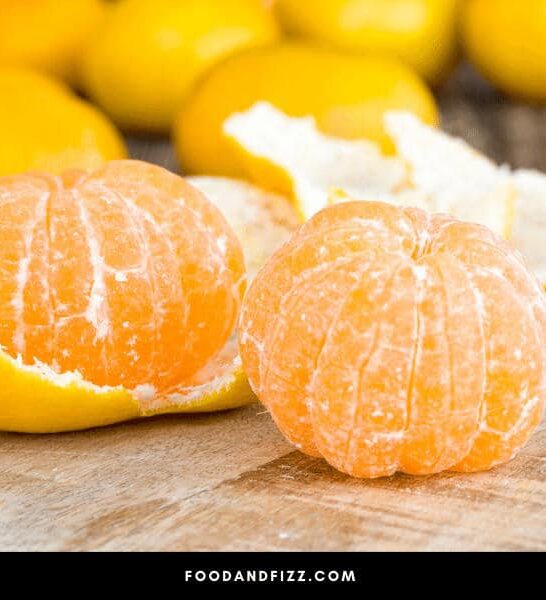When you think of an orange, the orange portion comes to mind. The peel is orange, as is the flesh of the orange. You may also notice white parts in the orange, and wonder what this is.
White Parts of Oranges
The white part of an orange is called the pith. Just like the flesh of the orange, it’s high in vitamin C and antioxidants. This makes it a healthy addition to your diet.

The Role of Orange Pith
Now you know what the white part of an orange is called, but why is it there? It’s essentially the orange’s version of connective tissue. In other words, the pith holds the pieces of orange together.
It attaches the orange flesh to the peel, and the sections of the orange to each other.

What Does Pith Taste Like?
Many people remove the pith because they believe it tastes bitter, similar to the peel. However, this isn’t true for oranges. It turns out the pith is actually tasteless.
The pith of lemon is slightly bitter, while grapefruit pith is quite bitter. Perhaps this is why we believe orange pith is bitter as well.
While the taste is essentially non-existent, it does have a strange texture. It’s chewy, and even spongy or chewy. This is another reason many people avoid it.
However, when eaten along with the rest of an orange, it’s barely noticeable.
The Pith is Healthy
It turns out that the pith has health benefits similar to the flesh of the orange. It’s high in vitamin C, antioxidants, and fiber.
Vitamin C
Vitamin C plays a surprising number of roles in the body. It is essential for the growth, development, and repair of all tissues within the body. It’s also necessary for the formation of collagen, absorbing iron, and skin health.
It’s most well known for its role in immune system function. It encourages the production of white blood cells, which protect the body from infection by killing invading cells. It also helps the white blood cells function more effectively.
It also helps strengthen the skin, which is a key aspect of immunity. The skin protects the body from bacteria and viruses in the environment.
As an antioxidant, it helps remove free radicals from the body. Free radicals cause damage to cells, and contribute to cancer, arthritis, and heart disease.

Antioxidants
Free radicals develop as part of the body’s natural processes. When the body metabolizes oxygen, oxidation occurs. This process causes free radicals within the body.
These free radicals steal electrons from cells in the body, causing damage to cells and DNA.
The body can cope with some free radicals. However, when there are too many free radicals, it raises the risk of serious disease in the body. These include heart disease, liver disease, and cancer. It also speeds the aging process.
Many factors can contribute to high levels of free radicals, including smoking, alcohol consumption, sunlight, and pollution.
Antioxidants, including Vitamin A, E, and C, neutralize free radicals within the body. Phytochemicals are also antioxidants. These include lycopene and anthocyanins.
Research has shown that antioxidants from whole foods, including oranges, are more effective than supplements. A diet high in antioxidants can slow aging, improve skin health, and reduce the risk of many types of cancer.
Fiber
Fiber doesn’t get nearly as much press as antioxidants, but it has a surprising number of health benefits as well.
Studies have shown that a high fiber diet is helpful in losing weight. Upping your fiber intake to the recommended amount of 30 grams per day can reduce your weight by 9 to 13 pounds over a year.
A high fiber intake can also help you maintain weight loss.
Fiber also lowers your risk of developing diabetes. Those who consume more than 26 grams of fiber per day have an 18% lower risk of diabetes compared to those who consume less than 19 grams per day.
Fiber is also good for your heart. In fact, every 9 grams of fiber drops your risk of heart disease by 9%.
Fiber will improve your gut bacteria within a few days, because it increases the amount of short chain fatty acids. A healthy gut microbiome is associated with decreased inflammation, increased immunity, and decreased risk of depression and anxiety.

How to Eat the Pith
The simplest way to eat the pith is to eat it with the rest of the orange. Peel the orange carefully to avoid removing more of the pith than necessary. Then, simply eat the orange, with the pith attached.
The other method for eating the pith is to grind it into a powder. You can then add it to orange desserts or marmalade for an extra nutritious punch.
Should You Eat Orange Peel?
Since you’ve learned the pith of the orange is good for you, you may be wondering about the orange peel.
Orange peel has a bitter taste, and it’s tough texture can make it unpleasant to eat. However, it is the most nutritious portion of the orange.
Most people don’t want to eat the orange peel as they would an orange, but this doesn’t mean you can’t incorporate it into your diet.
Consider grating the peel into zest. You can then add this to smoothies, cakes, salads, or orange marmalade.
You should wash the orange under hot water to remove any pesticide residue before using or consuming the peel, however.

Final Thoughts on Orange Pith
Orange pith may not be the most appealing part of an orange, but it’s packed with nutritional goodness. Instead of removing it from the orange, consume it along with the flesh of the orange.
Not only does this boost your nutrition, it’s also easier to eat the pith rather than attempting to remove it.
Frequently Asked Questions on White Parts of Oranges – What is it?
What is the Healthiest Part of An Orange?
The healthiest part of the orange is actually the peel. It has the highest amount of vitamin C and fiber. It also contains polyphenols that reduce the risk of many chronic diseases, including diabetes.
What Can I Do With Orange Pith?
If eating the pith with the orange isn’t appealing to you, toss it into a smoothie. It will give the smoothie a nutritious boost, and you will never know it’s there.

